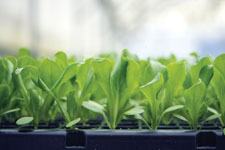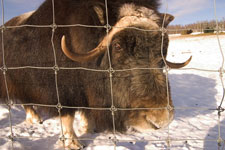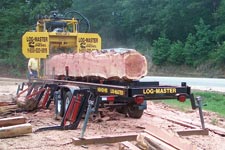Summaries of recent senior theses in the UAF School of Natural Resources & Agricultural

Photo credit: Roseann Leiner

Photo credit: UAF Photo by Todd Paris

Photo credit: UAF Photo by Todd Paris

Photo credit: Log-Master Portable Sawmilling

Photo credit: © Bill Glude, Southeast Alaska Avalanche Center
Lettuce seedling growth in flats with different cell size and shape
Research by Cody Peterson
Containerized transplants are used extensively for lettuce production in Alaska. Greenhouse
studies were conducted to determine effects of container cell size and shape on lettuce
(Lactuca sativa L. cv. Alpha) transplants. Volumes for square containers were 10 mL and 50 mL. Volumes for round
containers were 9.5 mL and 48 mL. Large square containers increased leaf number (11),
height (172 mm), root (0.110 g), shoot (0.584 g) and total weight (0.695 g), and decreased
hypocotyl length (7.8 mm) compared to both square and round small container cells.
Although not measured, large leaf area, hypocotyl diameter, and volume of roots were
observed for transplants grown in large compared to small containers. Effects of cell
shape were inconclusive. Root to shoot ratio was not significantly affected by container
cell size and shape. 'Alpha' lettuce transplants produced from large containers were
of higher quality than transplants produced from small containers. Further studies
evaluating transplant growth, field performance, cost, and compatibility are needed
to fully analyze container size and shape on lettuce production pertinent to Alaska.
Differences in qiviut quality between wild and domestic muskoxen and variation among
shoulder, side, and rump samples
Research by Jennifer L. Miller
Qiviut is a commercially valuable fiber derived from the undercoat of the muskox (Ovibos moschatus). A previous study examined qiviut collected from the shoulders of 299 wild muskoxen.
In this project, qiviut samples were collected from the shoulder, side, and rump of
20 muskoxen at the University of Alaska's Large Animal Research Station, UAF Institute of Arctic Biology. This study compares shoulder samples from the wild and domestic animals. It also
examines the variation among shoulder, side and rump samples collected from the domestic
animals. After receiving training from training from animal scientist Milan Shipka
on handling the animals, Miller collected the fiber samples. They were measured for
average fiber diameter (AFD), fiber diameter distribution (SD), and coefficient of
variation (CV) at the Wool and Mohair Research Laboratory, Texas A&M University. Miller
measured staple length manually, under the direction of fiber specialist Janice Rowell.
With the aid of professor Mingchu Zhang she is performing statistical analysis of
the data. Miller expects to complete her thesis in Spring 2006.
Electrical stimulation of reindeer carcasses during field slaughter and the effect
on meat tenderness
Research by George Aguiar
To meet State of Alaska regulations, field-slaughtered reindeer out on the Seward
Peninsula, Alaska, must be frozen immediately in the field after dressing. This abrupt
freezing may inhibit subsequent muscle tissue processes that influence meat quality.
Low voltage electrical stimulation (E.S.) has been used in the beef industry to avoid
undesirable meat characteristics due to flash freezing. Twenty-six reindeer steers
were field slaughtered during February and allowed to abruptly freeze. Thirteen animals
were stimulated prior to field dressing. A paired comparison consumer evaluation test
showed that front shoulder meat from E.S. carcasses was statistically more tender
than control carcasses (54 percent to 46 percent, p<.05, n=203). Electrical stimulation
before abrupt freezing in the field improves tenderness of fore shoulder reindeer
meat.
Opportunities for a small portable sawmill in eastern washington
Research by Cody Burgess
Technology has made portable sawmills efficient for cutting logs of various sizes
and producing lumber of all dimensions. Portable sawmills can be used to custom cut
lumber, taper saw for increased lumber recovery, and to minimize labor costs. A case
study was done in eastern Washington state using a Log-Master Model 5 portable sawmill.
The sawmill is owned and operated by Burgess Logging Inc., a company that is attempting
to expand their business. Eastern Washington forests contain highly valuable species
of timber, including ponderosa pine, Douglas fir, western red cedar, and others. From
June through August 2004, 6230 board feet of lumber were produced. Orders, stock material,
and chunks were sawed, which created a lumber recovery overrun of 511 board feet.
The results show that the Log-Master is efficient sawing logs between 8 inches and
24 inches in diameter. Log scaling and lumber grading rules and techniques were also
studied in order to become more familiar with the sawmilling business.
Avalanche knowledge, experience, and behaviors among winter backcountry users in Turnagain
Pass, Alaska
Research by Michael Gibson
Information concerning the avalanche knowledge, experience, and behaviors of winter
backcountry users assists public land managers and avalanche educators in developing
effective education campaigns that consider what messages to utilize and how to disseminate
those messages. This study investigated the relationship between these variables using
an on-site survey to collect information from motorized and non-motorized winter backcountry
users at popular backcountry access points in Turnagain Pass, Alaska, located in the
Chugach National Forest. Overall response rate was 92 percent. Across all respondents
mean behavior scores increased as knowledge and experience increased. The interaction
of knowledge and experience had a greater influence on behavior that looking at the
effects of each independently. Results indicate that avalanche knowledge and experience
interact at some basic level to positively influence behavior.


